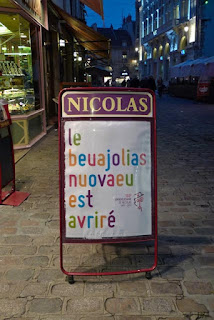According to a researcher (hic) at Salonic University, it doesn't matter in what order the letters in a word are, the only important thing is the quantity of Beaujolais Nouveau wine you have drunk before. This external advertising panel outside a Nicolas shop distills: "Le Beaujolais nouveau est arrivé" in a drunkard anagram: "Le beuajolias nuovaeu est avriré". See what it does to the poor Alan Parsons Project.
The ad takes on the September 2003 hoax on the unimportance of the order of letters, according to a forged researcher (sic) at Cambridge University (Aoccdrnig to a rscheearch at Cmabrigde Uinervtisy).
Even if not completely invalid, the hoax may be checked with Switcharoo! (Order of letters in a word doesn't matter? The hell it ...). For instance, it kinda works on Wim Sweldens' definition of the wavelet in the introduction for his PhD thesis, Construction and Application of Wavelets in Numerical Analysis, in 1994 (see the scrambled WITS: Where is the Starlet?)
It works with Dutch. I cannot equally read both texts. Here are two interesting texts, with studies in different languages, pertaining to the case. None from Cambridge university.
Carol Whitney. How the brain encodes the order of letters in a printed word: the SERIOL model and selective literature review. Psychon Bull Rev. 2001 Jun. 8(2):221-43, and associated publications.
Jonathan Grainger and Thomas Hannagan. Explaining word recognition, reading, the universe, and beyond: A modest proposal. Behavioral and Brain Sciences, August 2012.
Do not "Drunk in the gutter", "Greet unkind truth".
The ad takes on the September 2003 hoax on the unimportance of the order of letters, according to a forged researcher (sic) at Cambridge University (Aoccdrnig to a rscheearch at Cmabrigde Uinervtisy).
Even if not completely invalid, the hoax may be checked with Switcharoo! (Order of letters in a word doesn't matter? The hell it ...). For instance, it kinda works on Wim Sweldens' definition of the wavelet in the introduction for his PhD thesis, Construction and Application of Wavelets in Numerical Analysis, in 1994 (see the scrambled WITS: Where is the Starlet?)
Original: Uit de wiskundige analyse volgde dat de integraal van deze functie nul moet zijn en dat deze functie naar nul moet convergeren als het argument naar oneindig gaat. M.a.w. deze functie moet een beetje "schommelen" en dan geleidelijk uitsterven; het is een soort "lokaal golfje".
Scrambled: Uit de wskngdiuie aaslyne vdogle dat de igtanaerl van deze ficntue nul meot zijn en dat deze ficntue naar nul meot ceervongern als het agnumert naar oineindg gaat. M.a.w. deze ficntue meot een bteeje "seoemmhcln" en dan gileeeiljdk uirsteevtn; het is een sroot "lakaol gfojle".
It works with Dutch. I cannot equally read both texts. Here are two interesting texts, with studies in different languages, pertaining to the case. None from Cambridge university.
Carol Whitney. How the brain encodes the order of letters in a printed word: the SERIOL model and selective literature review. Psychon Bull Rev. 2001 Jun. 8(2):221-43, and associated publications.
This paper describes a novel theoretical framework of how the position of a letter within a string is encoded, the SERIOL model (sequential encoding regulated by inputs to oscillations within letter units). Letter order is represented by a temporal activation pattern across letter units, as is consistent with current theories of information coding based on the precise timing of neural spikes. The framework specifies how this pattern is invoked via an activation gradient that interacts with subthreshold oscillations and how it is decoded via contextual units that activate word units. Using mathematical modeling, this theoretical framework is shown to account for the experimental data from a wide variety of string-processing studies, including hemispheric asymmetries, the optimal viewing position, and positional priming effects.
Jonathan Grainger and Thomas Hannagan. Explaining word recognition, reading, the universe, and beyond: A modest proposal. Behavioral and Brain Sciences, August 2012.
In the last decade, reading research has seen a paradigmatic shift. A new wave of computational models of orthographic processing that offer various forms of noisy position or context-sensitive coding have revolutionized the field of visual word recognition. The influx of such models stems mainly from consistent ?ndings, coming mostly from European languages, regarding an apparent insensitivity of skilled readers to letter order. Underlying the current revolution is the theoretical assumption that the insensitivity of readers to letter order reflects the special way in which the human brain encodes the position of letters in printed words. The present article discusses the theoretical shortcomings and misconceptions of this approach to visual word recognition. A systematic review of data obtained from a variety of languages demonstrates that letter-order insensitivity is neither a general property of the cognitive system nor a property of the brain in encoding letters. Rather, it is a variant and idiosyncratic characteristic of some languages, mostly European, reflecting a strategy of optimizing encoding resources, given the specific structure of words. Since the main goal of reading research is to develop theories that describe the fundamental and invariant phenomena of reading across orthographies, an alternative approach to model visual word recognition is offered. The dimensions of a possible universal model of reading, which outlines the common cognitive operations involved in orthographic processing in all writing systems, are discussed.
Do not "Drunk in the gutter", "Greet unkind truth".



